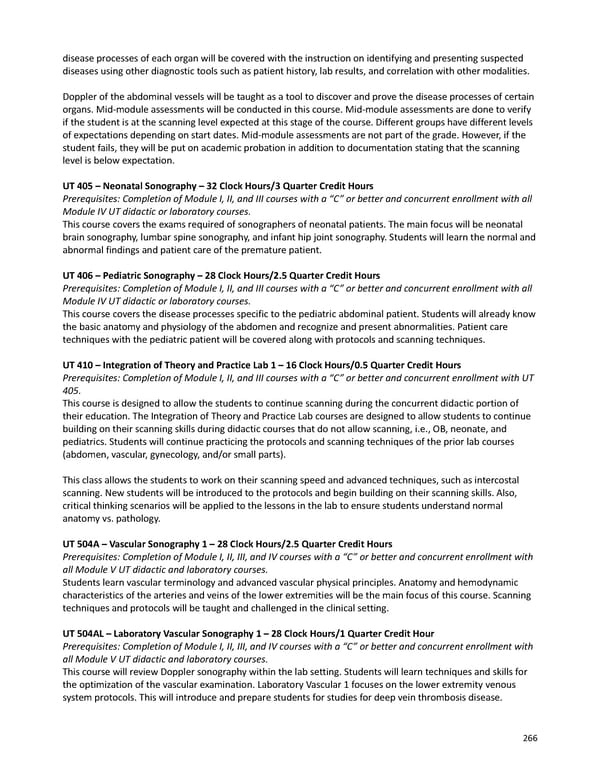disease processes of each organ will be covered with the instruction on identifying and presenting suspected diseases using other diagnostic tools such as patient history, lab results, and correlation with other modalities. Doppleroftheabdominalvesselswillbetaughtasatooltodiscoverandprovethediseaseprocessesofcertain organs. Mid-moduleassessmentswillbeconductedinthiscourse.Mid-moduleassessmentsaredonetoverify if the student is at the scanning level expected at this stage of the course. Different groups have different levels of expectations depending on start dates. Mid-module assessments are not part of the grade. However, if the student fails, they will be put on academic probation in addition to documentation stating that the scanning level is below expectation. UT405–NeonatalSonography–32ClockHours/3QuarterCreditHours Prerequisites: Completion of Module I, II, and III courses with a “C” or better and concurrent enrollment with all ModuleIVUTdidacticorlaboratorycourses. This course covers the exams required of sonographers of neonatal patients. The main focus will be neonatal brain sonography, lumbar spine sonography, and infant hip joint sonography. Students will learn the normal and abnormalfindingsandpatientcareoftheprematurepatient. UT406–PediatricSonography–28ClockHours/2.5QuarterCreditHours Prerequisites: Completion of Module I, II, and III courses with a “C” or better and concurrent enrollment with all ModuleIVUTdidacticorlaboratorycourses. This course covers the disease processes specific to the pediatric abdominal patient. Students will already know thebasicanatomyandphysiologyoftheabdomenandrecognizeandpresentabnormalities.Patientcare techniques with the pediatric patient will be covered along with protocols and scanning techniques. UT410–IntegrationofTheoryandPracticeLab1–16ClockHours/0.5QuarterCreditHours Prerequisites: Completion of Module I, II, and III courses with a “C” or better and concurrent enrollment with UT 405. This course is designed to allow the students to continue scanning during the concurrent didactic portion of their education. The Integration of Theory and Practice Lab courses are designed to allow students to continue building on their scanning skills during didactic courses that do not allow scanning, i.e., OB, neonate, and pediatrics. Students will continue practicing the protocols and scanning techniques of the prior lab courses (abdomen,vascular,gynecology,and/orsmallparts). This class allows the students to work on their scanning speed and advanced techniques, such as intercostal scanning. Newstudentswill be introduced to the protocols and begin building on their scanning skills. Also, critical thinking scenarios will be applied to the lessons in the lab to ensure students understand normal anatomyvs.pathology. UT504A–VascularSonography1–28ClockHours/2.5QuarterCreditHours Prerequisites: Completion of Module I, II, III, and IV courses with a “C” or better and concurrent enrollment with all Module V UT didactic and laboratory courses. Students learn vascular terminology and advanced vascular physical principles. Anatomy and hemodynamic characteristics of the arteries and veins of the lower extremities will be the main focus of this course. Scanning techniques and protocols will be taught and challenged in the clinical setting. UT504AL–LaboratoryVascularSonography1–28ClockHours/1QuarterCreditHour Prerequisites: Completion of Module I, II, III, and IV courses with a “C” or better and concurrent enrollment with all Module V UT didactic and laboratory courses. This course will review Doppler sonography within the lab setting. Students will learn techniques and skills for theoptimization of the vascular examination. Laboratory Vascular 1 focuses on the lower extremity venous systemprotocols. This will introduce and prepare students for studies for deep vein thrombosis disease. 266
 2023-2024 | Catalog Page 265 Page 267
2023-2024 | Catalog Page 265 Page 267